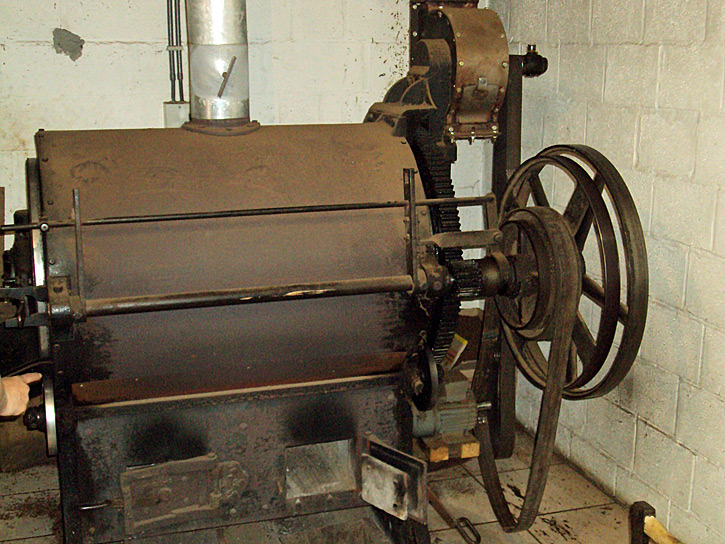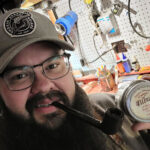Kevin Godbee
 I first heard of Semois tobacco about three years ago when an ex-girlfriend brought some back from Belgium as a gift. I thanked her, put it on the shelf and forgot about it. I had no idea at the time what unique stuff this was. So it just sat there for the last three years. (The last time she brought back some tobacco from overseas, it was crap, so that’s why I assumed this was too and didn’t even try it.)
I first heard of Semois tobacco about three years ago when an ex-girlfriend brought some back from Belgium as a gift. I thanked her, put it on the shelf and forgot about it. I had no idea at the time what unique stuff this was. So it just sat there for the last three years. (The last time she brought back some tobacco from overseas, it was crap, so that’s why I assumed this was too and didn’t even try it.)
Then Gregory Pease, whom most of you know as "the principal alchemist behind the blends of G.L. Pease Artisanal Tobaccos", and as a regular columnist for PipesMagazine, brought it up in a telephone conversation. He had recently been interviewed for an article about Semois that would appear in The New York Times Magazine. (You can read his intro to that article here.) In the least, Semois pipe tobacco has the allure of being hard to get. Just like Cuban cigars have an extra appeal to American citizens (that’s a whole article in itself), or like Coors Beer to the eastern U.S. prior to the 1980s. Anything that’s hard to obtain usually has you wanting it more.
I ran to my shelf and grabbed the pouch of Windels Grove Semois Coupe Grosse after learning how special Semois is—and that you can’t get it in the U.S. With The NY Times article coming out, I obviously must to do a review, and now I really wanted to! Greg told me to smoke it in a Corn Cob and a Meerschaum. I also heard that it would ghost a pipe. So here’s what I did. I grabbed my 1/4 bent apple meerschaum and headed to my local shop, House of Pipes & Cigars on MLK in St. Petersburg FL. It’s about a 10-minute drive.
House of Pipes & Cigars in St. Pete is small, and not the fanciest place in town, to put it nicely. However, the guys that hang out there are friendly. Most of them are cigar smokers, but they won’t give you strange looks for smoking a pipe. There is a small, but growing pipe smoker clientele, the coffee is great, and the owner, Michael Marks is fun to hang out with and talk about pipes, cigars and tobacco. I decided to purchase a $25 basket pipe so I could try the tobacco in a briar without the worry of ghosting a pipe, or tainting the experience with a pipe that had remnants of other tobaccos. I also drafted Mike, the owner of the store, to do a dual tasting with me. He smoked two bowls in a Missouri Meerschaum Corn Cob Pipe. I smoked one in the briar basket pipe and one in my meerschaum.
Since this tobacco is in the Burley family, described by other reviewers as being strong in nicotine, and me being a nicotine light weight, I made sure to eat a hearty lunch around 12:30 (a big Italian sub from Publix that my housekeeper brought for me – it was awesome), and smoked the tobacco after brushing my teeth and clearing my palate with water at 3 in the afternoon.
The last thing that you need to know before we get into the review is that this specific tobacco is NOT the one that was written about in Wil Hylton’s article in The NY Times.. He wrote about the Semois that is made by Vincent Manil.
There is also a little controversy about the Windels Semois. I have had some private communications and there is some public discussion in the comments here, basically calling bullshit on the Windels. Part of the comments from Salabreuil say; "Beware : the Semois is not an AOC (French initials for "controlled designation of origin" as in the wine world). Any tobacco may take the name of Semois – and a lot do. So be careful: if these tobaccos are not signed by one of these three producers, this is not Semois."
In addition, Arno665 told me that I have the worst version of Semois with the Windels. The really cool thing is that both of these guys are sending me some of what they say is the “good stuff". I will follow-up with a new review comparing and contrasting the different blends in a future write-up.
I had already smoked Windels Semois and made all of my notes about my experience for this review before being contacted by these two guys, so their opinions did not taint my review. My smoking experience was also prior to the New York Times Magazine article being published.
On to the review …
When I opened my 40-gram pouch of Windels Semois, it was compressed and came out intact as a solid brick. It wasn’t solid as if it had been in a tobacco press. It just all held together in the shape of the pouch, and broke up easily. (Click the photos for larger, more detailed images.)
The ribbon cut strands of tobacco display different shades of light and dark browns, along with tan and olive colors.
The tobacco is quite dry and clean feeling. It feels a little bit hard as well. The leaves are dryer than what most people are used to, but not too dry to smoke. It didn’t turn to dust, and it was still a tiny bit springy when packing the bowl.
Semois tobacco has no casings or toppings added to it. (Learn the difference between casing and toppings here.) I originally thought the tobacco was so dry because my pouch was three years old, but my new friends from France and The Netherlands tell me that it is supposed to be that dry, and that it will burn hot, so you better smoke it slow.
To remind you, the owner of House of Pipes (Mike) and I are doing a side-by-side review, and then we had a third pipe smoker join us when he entered the store. We made our notes separately so as to not influence one another, and I have compiled them here.
For the pouch aroma, Mike says grassy. For me it was cigar-like and barnyard. A mild-woodsy smell was how one of the cigar smokers in the shop described the unlit tobacco. A fourth, late participant, Steve Rosenthal (the 3rd pipe smoker mentioned above) said the pouch aroma was manure-like. He also said the texture is almost like Troost tobacco and similar to a dry-cured consistency. Steve normally smokes Lane 1Q, BCA, and light English blends. He hated the Windels Semois. He dumped his pipe after a few minutes. Mike and I each smoked two bowls.
The pre-light draw is floral and herbal. The initial light has a very soft mouth-feel to the smoke with loads of smoke while being light, airy and floral at the same time. It is kind of powdery feeling as well. This tobacco produces plenty of thick smoke while at the same time having subtle, mild aromas and flavors. The early part of the bowl tasted like dirt, but not in a bad way – earth after rain, and potting soil flavors and aromas are detected. There is a mild ash taste, which is common with Burley tobaccos, but it is more mild and tolerable here than in a typical American Burley-forward blend. Some Burley blends have too much ash taste for me, and create a burning at the back of the throat. That did not happen here. Mike agreed with the mild floral taste in the early stages of the bowl.
In the corncob that Mike is smoking, he is tasting baked goods and bread. In my briar pipe, it is similar with an additional burnt sweetness like a faint caramel.
At the half-way point, Mike and I both had a little buzz. The tobacco burns so well that I probably could have smoked the entire bowl with only one or two relights, but I had to go slow and let it go out a few times so my nicotine buzz would stay on the nice mellow side without getting ugly. Another reason I had to stop puffing and let the bowl go out was because the dry tobacco smokes hot.
About 75% of the way through the bowl we agree that burnt toast is now the dominant flavor. The floral, herbal notes come back to the forefront later, and keep trading places back and forth with the baked goods and burnt toast flavors. Overall, the flavor is quite mild and there is a little nicotine buzz, but it is a good relaxing effect. Earlier in the day I was hectic and stressed, but after smoking this, I am completely relaxed.
Everybody in the retail shop thought I was weird when I said the pouch bouquet reminds me of smelling an unlit cigar, but look at this – the side of the pouch reads: Tabak en sigaren … guess what Holmes? Sigaren means Cigar. So there!
I’m not a fan of straight Burley or Burley-forward blends – but Semois is a straight, all-natural Burley and I do like it. Remember, this is probably one of the only pipe tobaccos in the world that has no casing whatsoever. It also has no toppings like many, but not all tobaccos do. It displays some Burley characteristics. There is a light ash flavor without the heavy ash and back of the throat burning distinctiveness that some Burleys demonstrate. It did not have the nuttiness that is often common with Burley leaf.
Mike brought up the fact that some tobaccos will make your mouth dry, and others will make you salivate. The Semois seems to cause you to produce saliva.
This is a great tobacco for retro-haling. You get a new flavor that is a heavier, sweeter floral essence.
One of the things that makes Semois so special is the extremely unique terroir, and this is where PipesMagazine member Salabreuil takes issue with the Windels brand – saying it is not actually tobacco from the Ardennes region. I would still not pass up the opportunity to get some though.
The other thing that makes Semois so unique is the way it is processed. Just like no other pipe tobacco is processed like Perique, the same can be said for Semois. No tobacco goes through the exact same process. It starts out like all Burleys and most cigar tobacco by being air-cured, but then something unique is done to it.
PipesMagazine member Arno665 and I had an interesting discussion about this. I was reading his blog post on Semois where he originally described the tobacco as being air-cured and then flue-cured. I took issue with the flue-curing being correct. He replied that flue-curing adds indirect heat, which is what happens after the air-curing.
In a way, this could be considered somewhat semantics as flue curing does provide indirect heat (with no smoke) to speed up the curing process. However, the reason I wouldn’t refer to Vincent’s process as flue curing is because flue curing is known to be very specific where there are specially made barns with a specific system of tubes (flues) that direct hot air into the barn. The temperature is very closely monitored and adjusted when needed. You can see an illustration and description of actual flue-curing in this article.
Semois is Air-Cured and then kind of Heat-Cured. The tobacco is toasted in a custom contraption that is like a word-burning oven. Here is a photo that Arno665 sent from when he visited Vincent Manil.

Ironically, even though the local guys (in France and The Netherlands, not Belgium where this actually comes from) that are experienced with Semois told me that Windels is the worst example, and perhaps not even Semois, I enjoyed the Windels Semois quite a bit! And by the way, that bit about it ghosting a pipe is hogwash.
I would definitely smoke it again and I would get more if the opportunity arises. I would encourage you to do so as well. I thought this would end up being another reason to be mad at my ex-girlfriend, but instead, I had to call her and thank her. Damnit.
If you normally smoke aromatics, this might not be for you, based on Steve dumping his pipe. If you solely smoke heavy Latakia blends, the Windels Semois might be too subtle for you.
Personally, I wouldn’t smoke this on a regular basis, but I would smoke it as a semi-regular routine when I want a change things up. I usually smoke English, Oriental and Balkan-style blends the most, but I also like straight Virginias and Virginia-Perique blends. I like Burley blends the least, but I like Semois 5-times better than a standard American-type Burley.
I definitely recommend it, and can’t wait to get the additional samples to compare. We normally end with giving a link to buy the tobacco, but this time, I’ll just say – happy searching!























Thanks for this review, Kevin. I’m looking forward to your thoughts about Vincent Manil’s Semois.
Excellent review Kevin!!!
And: “And by the way, that bit about it ghosting a pipe is hogwash.” Wait ’till you get the real stuff 😉
Ha! Maybe I need to use the Meer or the new basket pipe anyway.
Thanks for the review Kevin! Sounds like an interesting tobacco and I’m excited to hear about Vincent Manil’s legit semois and see how it differs. Either way this blend seems like it would be tasty for those who like VaBur or more oriental forward blends.
Kevin, The NY Times article was brought to my attention by a true anti-smoking individual, but he soon began asking me many questions about pipes,tobacco, pipe shops, etc. It seems that the article made him more than just curious, I think he wants to pick up a pipe and join our fraternity of pipers ! That’s the second guy this week who wants to go pipe shopping with me. May be for once the power of the press is working in our favor.
Den
Great to hear Den!
Great review – sounds like this tobacco is right up my alley. I’ll be sure to keep an eye out for it. Thanks.
Thanks for a very informative article. I especially appreciate the photos. Wine, cheese and tobacco reviews are really challenging to do, and you make verbal descriptions of the palate’s experience seem effortless.
Nice review Kevin thanks. Semois does sound interesting. I wouldn’t turn down an opportunity to try it out. That was nice of you to call up the old flame and thank her!
Should we start an over/under pool to guess how many days it will be before someone has the up for grabs on eBay or BriarBid??
I couldn’t agree more with arno665 🙂
And with good stuff, I can’t wait to read your review.
Thanks Antoine!
Thanks for the in depth review, Kevin. I’m looking forward to your review of the other brands.
If I had known about this last year, I would have asked my ex to look for some when she went to Italy for several weeks.
It would be great if someone would import it, so all those interested can try it.